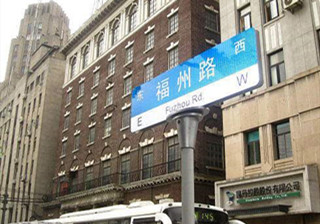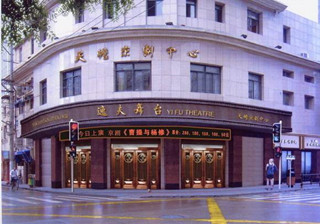- +86-13267351235
- info@globalstourtravels.com
Steeped in the history of China's literary giants, Fuzhou Lu is marked with the  brands of its era and civilization. This 1.5 kilometer road is a landmark of Shanghai culture.
brands of its era and civilization. This 1.5 kilometer road is a landmark of Shanghai culture.
The tale of Fuzhou Lu, traces back to the beginnings of urban Shanghai. Before the opening of Shanghai's ports, Fuzhou Lu was nothing more than a collection of four dirt paths (called the "Four Horse Roads" by locals) leading to the Bund. By the 1850's, these four dirt paths came to be called "Evangelical Road" because Walter Medhurst, a director at the Municipal
Council and a missionary with the London Missionary Society did missionary work nearby. After the ports opened, Fuzhou Lu was scheduled for construction after Xuandao Road (later called two horse road and today's Jiujiang Road) and together with Yingda Malu (Nanjing Donglu).
Today's sleepy Fuzhou Lu, palled and plain, was once a fountainhead of Shanghai culture and literature. The fluent Chinese-speaking British evangelical missionary and sinologist, Walter Henry Medhurst, founded China's first publishing organization, The London Missionary Society Press, on a ring of land around Shandong Lu. This area eventually came to be called the Mai Family Circle after Medhurst's Chinese name, Mai Dusi. To facilitate the propagation of western learning throughout China, Med-hurst hired a group of down and out writers as his "gunners". Called the binghua bishi or Master China Writers, these highly educated writers had a strong foundation in Chinese civilization and Western culture. In the years to come, these men would become the originators of a new Shanghai culture and literature. Many of the Master Writers remained on Fuzhou Lu, establishing a large succession of the newspaper offices, book stores, and printing houses.
On April 30, 1872 British businessman, Ernest Major, founded modem China's oldest Chinese language newspaper, Shenjiang Xinbao (Shenbao), on the stretch along Fuzhou Lu, Wangping Street, and Three Horse Road. The editors in chief at the time blended concepts of Eastern and Western media and formed a media company with its own Shanghai style. Chinese newspaper writers from all over the country flocked into the area, and before long, this 1453 meter stretch of the Four Horse Roads became a surprisingly boisterous collection of over 100 book and newspaper organizations. With publishing houses both big and small, the Four Horse Roads were at the veritable forefront of Shanghai publishing. The 1872 creation of Shenbao was followed in 1893 by Xinwenbao, and soon, over ten different newspapers were packed onto this small strip. Newspaper dealers would swarm the area twice a day, at dawn and in the after-noon, selling papers and creating a general hubbub.
Over a century later, Fuzhou Lu is still a publication center. The Shanghai Technology Book Company, the Distribution Office for Business Book Printing. Shanghai Foreign Language Book Company, the Shanghai Book Mall (± and the Huangpu District Library, can all be found here as well as a hefty collection of independent book stores and libraries.
Not surprisingly, this is a great place to come book shopping. If you do not under-stand Chinese, you may have to look find something to interest you here. Perhaps you may stumble across a hidden gem in one of the foreign language bookstores.

Located at the comer of Fuzhou Lu and Xinjiang Lu, this was once the location of Hui Le Li, known by the locals as "Prostitute's Den" due to the 151 brothels opened in the 28 stone warehouse buildings along this lane. The brothels were all shut down by 1948.
Raffles City currently occupies this former address of ill repute. This market carries everything you could expect to find in a store of its size.
Another of Fuzhou Lu's famous spots is the Yifu Theater (also called the Tianchan Theater), located on the comer of Fuzhou Zhonglu and Yunnan Lu. This, at one time, was the largest theater in Shanghai. In 1921, wealthy Shanghai merchant and author Li Zhiwu leased a huge tract of land along Fuzhou Lu stretching from Xizang Zhonglu to Yunnan Nanlu. He paid the English property holder a huge amount of money for a 25 year long lease, and then hired a British designer to design the theater. Construction was completed in 1925, and for a short while, it became the largest Chinese Opera Theater in Shanghai, and attracted famous artists such a Lu Mudan (Huang Yulin), Qi Lintong (Zhou Xinfang), and Gai Jiaotian to perform on stage. Famed Peking opera artists from Beijing, Mei Lanfang, Li Wanchun, and Jiang Miaoxiang also journeyed south to Shanghai to perform on the theater's new stage. The "sold out" sign became a daily fixture hanging from top of the theater entrance. Tickets for the new theater were priced at 50 pieces of gold.
In 1957 the newly formed Beijing Peking Opera Company,  which included such no-table performers Ma Lianliang, Zhang Junqiu, and Qiu Shengrong, performed to full houses at the Yifu Theater for two straight months beginning in April 14 and lasting until June 6. Wealthy industrialist and patriot, Shao Yifu, donated money in 1994 to reconstruct Tianchan Theater. In honor of his contribution, the theater's name was formerly changed to the Tianchan Peking Opera Center's Yifu Theater, known today simply as the Yifu Theater.
which included such no-table performers Ma Lianliang, Zhang Junqiu, and Qiu Shengrong, performed to full houses at the Yifu Theater for two straight months beginning in April 14 and lasting until June 6. Wealthy industrialist and patriot, Shao Yifu, donated money in 1994 to reconstruct Tianchan Theater. In honor of his contribution, the theater's name was formerly changed to the Tianchan Peking Opera Center's Yifu Theater, known today simply as the Yifu Theater.
Aside from Peking Opera, the theater also holds performances of Shaoxing Opera, Shanghai Opera and others. Please visit their English language website for up-to-date information about current and future performances.
Fuzhou Lu is lined with old buildings and attractive architecture. The most famous of which can be found at intersection of Fuzhou Lu and Jiang Xilu. Built in the 1930's, these three buildings are built of equal height and similar appearance. The Hamilton House (today's Fuzhou Building) is located at the southeastern comer of the road. To the Northeast is the Metropole Hotel, and the Development Building is in the Southwest. These three structures, which fan into a U shape around the street comer, were the skyscrapers of their day. A British style bar is located on the bottom floor of the Hamilton House.